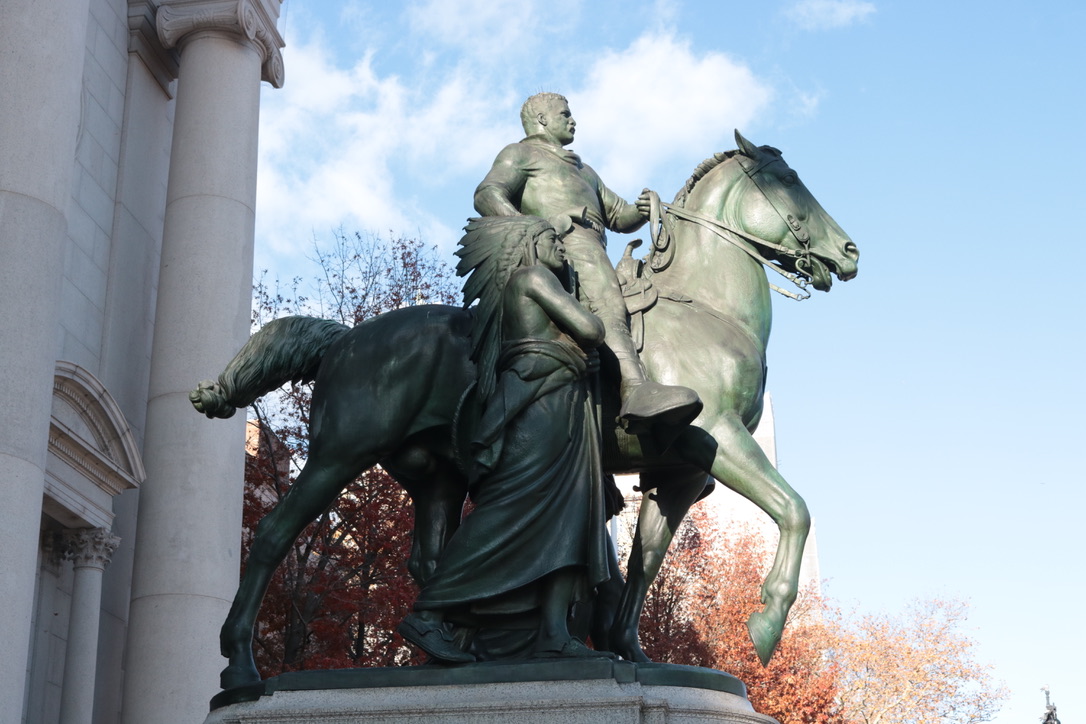
- Details
- By Jenna Kunze
The controversial Theodore Roosevelt statue was quietly removed from its decades-long perch in front of the American Museum of Natural History in New York City Wednesday night by museum contractors.
The planned removal was completed around 1 a.m. Thursday morning, when a crane removed the bronze portion of the statue, museum spokesperson Scott Rohan wrote in an email to Native News Online. The remaining base of the statue will be removed throughout the week, and the restoration of the plaza will continue through the spring.
The statue, which depicts racial hierarchy, with Theodore Roosevelt on horseback flanked by a Native American man and an African-American man on either side below him, will be stored in New York as it is prepared for shipping, Rohan said. It is slated to be repurposed in a “contextualized” exhibit at the Theodore Roosevelt Presidential Library in Mendora, North Dakota.
Want more Native News? Get the free daily newsletter today.
The New York Department of Transportation required that the statue’s removal happen at night “for safety reasons and to minimize disruption to traffic and pedestrians,” Rohan wrote. “These are the designated hours for this type of work.”
But that hasn’t historically been the case for statue removals. In April 2018, the city and the Museum of the City of New York removed a public statue of J. Marion Sims from 5th Avenue and East 103rd St. in East Harlem, during daylight hours as spectators watched and cheered. Sims was a 19th century surgeon who experimented on enslaved women, without anesthesia. He was also known as the “father of gynecology.”
This past November, New York City removed its Thomas Jefferson statue from City Hall, because of the former president’s history of owning slaves. According to reports at the time, work crews spent hours moving the statue, also during daytime hours.
Rohan later elaborated on the reason for removing the statue overnight, writing to Native News Online, “... to obtain a permit the Department of Transportation required that the work take place at night due to the location of the work. The size and scale of the operation required a large crane operat[ing] from Central Park West, which necessitated lane closures and redirection of traffic. Central Park West and the nearby 81st Street traverse are high volume passageways affecting traffic flows of the East and West side of Manhattan which was a factor, in addition to ensuring pedestrian safety."
The fate of the so-called "Equestrian Statue" has been in limbo since June 2020, when the police killing of George Floyd in Minneapolis begat nationwide protests against racism. But Indigenous, African American, and other people living in the City have long objected to the statue, for the racial hierarchy the statue portrays and for the land allotment system Roosevelt championed, at the cost of displacing Natives of more than 230 million acres of their land.
Roosevelt is also remembered for his support of eugenics, and his public address in 1886 where he said: “I don’t go so far as to think that the only good Indians are the dead Indians, but I believe nine out of every 10 are. And I shouldn’t like to inquire too closely into the case of the tenth.”
Of African Americans, Roosevelt wrote, “As a race and in the mass they are altogether inferior to the whites.”
In response to last year’s protests, the City of New York, which owns the building and property housing the American Museum of Natural History and the steps where the statue sits, agreed to take it down. Mayor Bill de Blasio backed the decision, saying the “problematic” statue “explicitly depicts Black and Indigenous people as subjugated and racially inferior.”
Native Americans in North Dakota are wary of receiving it. United Tribes Technical College President Leander McDonald (Spirit Lake Tribe) previously told Native News Online that using the statue to portray the true history of Roosevelt could be educational.
“If they're going to have something there that provides an accurate history of this president and how he felt towards tribal and Black people, then maybe there’s an educational opportunity for the public,” he said. “If that’s truly going to happen.”
This story has been updated to include further information from Scott Rohan at the American Museum of Natural History.
More Stories Like This
Native News Weekly (August 25, 2024): D.C. BriefsUS Presidents in Their Own Words Concerning American Indians
Native News Weekly (December 14, 2025): D.C. Briefs
Wounded Knee Massacre Site Protection Bill Passes Congress
Two Murdered on Colville Indian Reservation
Help us defend tribal sovereignty.
At Native News Online, our mission is rooted in telling the stories that strengthen sovereignty and uplift Indigenous voices — not just at year’s end, but every single day.
Because of your generosity last year, we were able to keep our reporters on the ground in tribal communities, at national gatherings and in the halls of Congress — covering the issues that matter most to Indian Country: sovereignty, culture, education, health and economic opportunity.
That support sustained us through a tough year in 2025. Now, as we look to the year ahead, we need your help right now to ensure warrior journalism remains strong — reporting that defends tribal sovereignty, amplifies Native truth, and holds power accountable.
 The stakes couldn't be higher. Your support keeps Native voices heard, Native stories told and Native sovereignty defended.
The stakes couldn't be higher. Your support keeps Native voices heard, Native stories told and Native sovereignty defended.
Stand with Warrior Journalism today.
Levi Rickert (Potawatomi), Editor & Publisher

